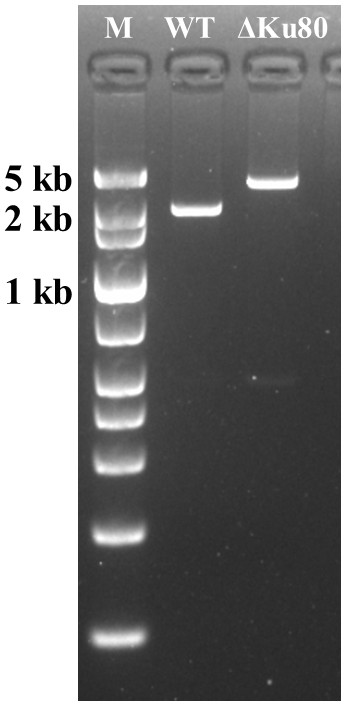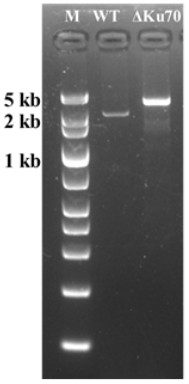Method for constructing thermophilic mycelia strain with high homologous recombination efficiency and application of thermophilic mycelia strain
A technology for Myceliophthora thermophila and Myceliophthora thermophila is applied in the field of genetic engineering and can solve the problems of not improving the efficiency of mammalian cells, increasing the efficiency of site-specific integration of DNA sequences, and unclear knockout.
- Summary
- Abstract
- Description
- Claims
- Application Information
AI Technical Summary
Problems solved by technology
Method used
Image
Examples
Embodiment 1
[0028] Example 1 Construction of Myceliophthora thermophila Genetically Engineered Strain ΔKu80 Knockout of Ku80 Gene
[0029] 1. Construction of Ku80 gene knockout cassette
[0030] To construct the Ku80 gene knockout cassette, the primers are as follows:
[0031] Ku80-F1 (SEQ ID NO: 4), Ku80-R1 (SEQ ID NO: 5);
[0032] Ku80-F2 (SEQ ID NO: 6), Ku80-R2 (SEQ ID NO: 7);
[0033] G418-F1 (SEQ ID NO: 8), G418-R1 (SEQ ID NO: 9).
[0034] Using the genome DNA of Myceliophthora thermophila as the template, the Ku80 gene fragment was amplified with the primers Ku80-F1 / Ku80-R1, and the amplified product was recovered and connected to the pEASY-Blunt vector, transformed into the Trans I clone host, and sequenced to verify the intermediate vector. pEASY-Blunt-Ku80; secondly, using pEASY-Blunt-Ku80 as a template, primers Ku80-F2 / Ku80-R2 were used to amplify the upstream and downstream of the Ku80 gene fragment, and the amplified product was recovered and passed through the geneticin G4...
Embodiment 2
[0039] Example 2 Construction of Myceliophthora thermophila Genetically Engineered Strain ΔKu70 Knockout of Ku70 Gene
[0040] 1. Construction of Ku70 knockout cassette
[0041] The primers used to construct the Ku70 knockout cassette are as follows:
[0042] Ku70-F1 (SEQ ID NO: 10), Ku70-R1 (SEQ ID NO: 11);
[0043] Ku70-F2 (SEQ ID NO: 12), Ku70-R2 (SEQ ID NO: 13);
[0044] G418-F1 (SEQ ID NO: 14), G418-R1 (SEQ ID NO: 15).
[0045]Using the genomic DNA of Myceliophthora thermophila as a template, the Ku70 gene fragment was amplified with the primers Ku70-F1 / Ku70-R1, and the amplified product was recovered and connected to the pEASY-Blunt vector, transformed into a Trans I clone host, and sequenced to verify the intermediate vector. pEASY-Blunt-Ku70; secondly, using pEASY-Blunt-Ku70 as a template, primers Ku70-F2 / Ku70-R2 were used to amplify the upstream and downstream of the Ku70 gene fragment, and the amplified product was recovered and passed through the geneticin G418 r...
Embodiment 3
[0050] Example 3 Homologous recombination efficiency verification in Myceliophthora thermophila genetically engineered strains ΔKu80 and ΔKu70
[0051] 1. Construction of alp1 knockout cassette
[0052] The primers for the alp1 knockout cassette were constructed as follows:
[0053] alp1-F1 (SEQ ID NO: 16), alp1-R1 (SEQ ID NO: 17);
[0054] alp1-F2 (SEQ ID NO: 18), alp1-R2 (SEQ ID NO: 19);
[0055] HygR-F1 (SEQ ID NO: 20), HygR-R1 (SEQ ID NO: 21).
[0056] Using the genome DNA of Myceliophthora thermophila as a template, the alp1 gene fragment was amplified by primers alp1-F1 / alp1-R1, and the amplified product was recovered and connected to the pEASY-Blunt vector, transformed into a Trans I clone host, sequenced and verified to obtain an intermediate vector pEASY-Blunt-alp1; secondly, using pEASY-Blunt-alp1 as a template, primers alp1-F2 / alp1-R2 were used to amplify the upstream and downstream of the alp1 gene fragment, and the amplified product was recovered and passed thr...
PUM
 Login to View More
Login to View More Abstract
Description
Claims
Application Information
 Login to View More
Login to View More - R&D
- Intellectual Property
- Life Sciences
- Materials
- Tech Scout
- Unparalleled Data Quality
- Higher Quality Content
- 60% Fewer Hallucinations
Browse by: Latest US Patents, China's latest patents, Technical Efficacy Thesaurus, Application Domain, Technology Topic, Popular Technical Reports.
© 2025 PatSnap. All rights reserved.Legal|Privacy policy|Modern Slavery Act Transparency Statement|Sitemap|About US| Contact US: help@patsnap.com



